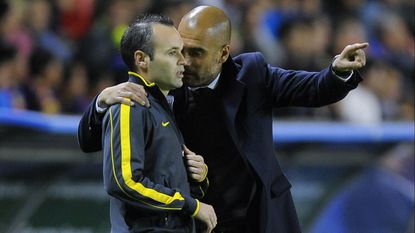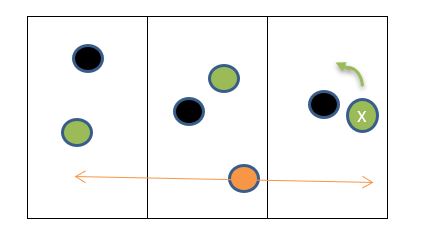01.25.20Notes for Coaches: The Story of a Stoppage

As coaching goes, my daughter is lucky. She plays for a great club: serious about teaching and hires top quality coaches. Her coach this year is just what you’d want as a parent and a student of the game: builds positive culture; values teamwork and integrity; knows the game, respects it, teaches it right. He’s also humble–accomplished coach of a legit collegiate program but still loves to learn. As a result I’ve been able to observe him coach a few times this season.
With his approval I want to share the ‘story’ of one of his stoppages from training this week. It was in many ways a perfect stoppage, but I don’t think it changed the girls’ long-term behavior as much as it might have and thinking about this made me realize some things that are probably useful to other coaches.
Here’s the story:
The girls were playing 3v3+1 in a 3-part grid, black vs green. Each of the players on the black and green teams were tied to one of the thirds but the +1 (orange) could go anywhere. Like this:

The set-up caused players to have to create space and separation from their defenders. If they did, they would reliably be rewarded with the ball. At one point, with the neutral holding the ball and green in possession, the player marked with the X tried to get open by making a looping run behind her defender (arrow). The defender easily covered it and she was unsuccessful.
The coach paused play. To get open in a situation like this, he explained, you often have to make two runs: one for the defender and one for the ball. He then showed her how to take a few steps as if making the original run (the run ‘for the defender’) and then reverse direction back into the space she’d vacated (the run ‘for the ball’). He then had her try this. Even though the defender knew it was coming, the unpredictability of the timing and the fact that he had shown her how to make the move in the defender’s blind spot made the run successful. Light bulb. She received the ball and away they went.
It was, from my (teaching) perspective, an almost perfect stoppage. First, the skill he highlighted was sophisticated, important and applicable across settings. It guided play off the ball which is far less coached than but at least as important as what players do on the ball.
Second, the fundamentals of a good stoppage were all there:
- It was fast… about 25 seconds.
- It was focused on one single idea only-no overload to working memory
- It used correction, instead of just critique. The object player had the chance to rehearse the required action not just hear about it.
- Players applied the idea right away
- It used fantastic language. “Two runs: One for the defender, one for the ball.” Perfect: Clear. Concise. Memorable.
And not just memorable to me. Memorable to them. After the coach said “Play,” you could see the girls using the idea… applying and adapting it… you could see the change in their movements. It was powerful.
But only for a little while…. That was the Achilles Heel and for me the lesson.
Less than a minute later the coach made another stoppage on a different topic. The second stoppage was almost as well done as the first in terms of fundamentals of teaching and worthiness of topic but it had the result essentially of erasing the first one from players’ working memory. The girls as they played were now thinking of the second stoppage and they stopped making the movements they’d been making off the ball after the first stoppage.
And the fact is that they needed more time to build the habit of two runs, to understand it, and begin encoding it in memory.
They could have spent 20 minutes or more experimenting with the idea of getting in their defender’s blind spot and unbalancing her with a false run … realizing that sometimes you really have to sell the first run with a quick change of body language for example or that sometimes it’s actually three runs… fake run/fake check back/continue initial run, etc.
But they had less than a minute and, I suspect, encoded little of the progress they were making in habit and long-term memory.
I think that’s useful for coaches to think about. Time to use and apply an idea is necessary to learning. The goal if we want to increase learning is to sustain focus on an idea–and if we really want to accelerate learning, to focus on it and then let players begin to forget about it and then come back to it. The teaching happens in the stoppage, but the learning happens only when there is a sustained opportunity to use the ideas we discuss afterwards. Maintaining focus on ideas so that athletes can use them and think about them for sustained periods of time often means not moving on to the next idea when we’ve taught something well. In a perfect world there would be a sustained zen-like study of thinking about changing pace and direction off the ball.
The practical actions for coaches to consider here are to:
- Extend the amount of play time after each stoppage to ensure that layers get to use the idea.
- Remind athletes of what they’re working on—“unbalance your defender girls; change pace and change direction”—while they are playing so they continue to seek opportunities to use it
- Have multiple stoppages focus on the same topic of some new variation on for a significant stretch of time (10, 12,15 minutes)
- Come back to the topic later in the session for retrieval practice and again during the next session or two perhaps, even if briefly, to drive the nascent habit into long-term memory.
A good coach can teach more in 90 minutes than players can learn and in many ways that’s the hardest part of the job … doing more by focusing on less.
